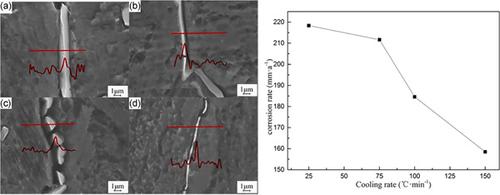当前位置:
X-MOL 学术
›
Mater. Corros.
›
论文详情
Our official English website, www.x-mol.net, welcomes your
feedback! (Note: you will need to create a separate account there.)
Effects of cooling rate on the precipitation behavior of grain boundary carbide and corrosion resistance of 5Cr15MoV stainless steel
Materials and Corrosion ( IF 1.6 ) Pub Date : 2020-01-30 , DOI: 10.1002/maco.202011505 Han Yan 1 , Zhijun He 1 , Nan Lü 1 , Chongyi Wei 2 , Taixu Xu 1 , Jihui Liu 1
Materials and Corrosion ( IF 1.6 ) Pub Date : 2020-01-30 , DOI: 10.1002/maco.202011505 Han Yan 1 , Zhijun He 1 , Nan Lü 1 , Chongyi Wei 2 , Taixu Xu 1 , Jihui Liu 1
Affiliation

|
High‐carbon and high‐chromium alloy steels are prone to pitting and intergranular corrosion, which reduces corrosion resistance. The precipitation behavior of the carbides of high‐carbon and high‐chromium alloy steels is one of the main factors affecting pitting and intergranular corrosion of stainless steel. In this study, 5Cr15MoV stainless steel was heated to 1,200℃ and then cooled by cooling rates varying from 25 to 150°C/min. The precipitation behavior of grain boundary carbides of 5Cr15MoV steel at different cooling rates, and its effect on the corrosion resistance of materials was studied. The results show that the carbides of 5Cr15MoV steel mainly precipitate along the grain boundaries, which leads to the formation of chromium‐depleted zones near the grain boundaries and reduces resistance to intergranular corrosion. It has been found that a higher cooling rate shortens the width of the Cr‐depleted zone near the boundary from 0.871 to 0.569 μm, reduces the Cr‐concentration gradient near the grain boundary from 36.422% to 12.667%, and suppresses the nucleus growth rate of grain boundary carbides. As the cooling rate increases, the corrosion current density decreases from 13.29 to 2.42 μA/cm2. The corrosion rate is the lowest, while the cooling rate is 150°C/min. The corrosion rate decreases from 218.339 to 158.488 mm/a. The phenomenon of intergranular corrosion and pitting corrosion was found to be weakened; and thereby, it is shown that an intensive cooling rate can improve the corrosion resistance of 5Cr15MoV steel.
中文翻译:

冷却速度对5Cr15MoV不锈钢晶界碳化物析出行为和耐蚀性的影响
高碳高铬合金钢容易出现点蚀和晶间腐蚀,从而降低了耐蚀性。高碳高铬合金钢的碳化物的析出行为是影响不锈钢点蚀和晶间腐蚀的主要因素之一。在这项研究中,将5Cr15MoV不锈钢加热到1200℃,然后以25至150°C / min的冷却速率进行冷却。研究了5Cr15MoV钢在不同冷却速率下的晶界碳化物的析出行为,及其对材料耐蚀性的影响。结果表明,5Cr15MoV钢的碳化物主要沿晶界析出,这导致在晶界附近形成贫铬区,并降低了对晶间腐蚀的抵抗力。已经发现,较高的冷却速率可使边界附近的Cr贫化区的宽度从0.871缩短至0.569μm,使晶界附近的Cr浓度梯度从36.422%降低至12.667%,并抑制了晶核生长速率晶界碳化物。随着冷却速率的增加,腐蚀电流密度从13.29降至2.42μA/ cm2。腐蚀速率最低,而冷却速率为150°C / min。腐蚀速率从218.339毫米降至158.488毫米/年。发现晶间腐蚀和点蚀的现象减弱了。由此表明,强化的冷却速度可以提高5Cr15MoV钢的耐腐蚀性。
更新日期:2020-01-30
中文翻译:

冷却速度对5Cr15MoV不锈钢晶界碳化物析出行为和耐蚀性的影响
高碳高铬合金钢容易出现点蚀和晶间腐蚀,从而降低了耐蚀性。高碳高铬合金钢的碳化物的析出行为是影响不锈钢点蚀和晶间腐蚀的主要因素之一。在这项研究中,将5Cr15MoV不锈钢加热到1200℃,然后以25至150°C / min的冷却速率进行冷却。研究了5Cr15MoV钢在不同冷却速率下的晶界碳化物的析出行为,及其对材料耐蚀性的影响。结果表明,5Cr15MoV钢的碳化物主要沿晶界析出,这导致在晶界附近形成贫铬区,并降低了对晶间腐蚀的抵抗力。已经发现,较高的冷却速率可使边界附近的Cr贫化区的宽度从0.871缩短至0.569μm,使晶界附近的Cr浓度梯度从36.422%降低至12.667%,并抑制了晶核生长速率晶界碳化物。随着冷却速率的增加,腐蚀电流密度从13.29降至2.42μA/ cm2。腐蚀速率最低,而冷却速率为150°C / min。腐蚀速率从218.339毫米降至158.488毫米/年。发现晶间腐蚀和点蚀的现象减弱了。由此表明,强化的冷却速度可以提高5Cr15MoV钢的耐腐蚀性。











































 京公网安备 11010802027423号
京公网安备 11010802027423号